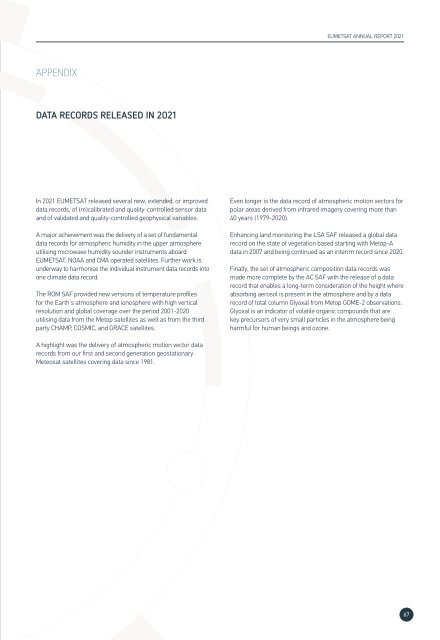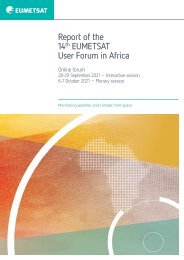EUMETSAT Annual Report 2021
You also want an ePaper? Increase the reach of your titles
YUMPU automatically turns print PDFs into web optimized ePapers that Google loves.
<strong>EUMETSAT</strong> ANNUAL REPORT <strong>2021</strong><br />
APPENDIX<br />
DATA RECORDS RELEASED IN <strong>2021</strong><br />
In <strong>2021</strong> <strong>EUMETSAT</strong> released several new, extended, or improved<br />
data records, of (re)calibrated and quality-controlled sensor data<br />
and of validated and quality-controlled geophysical variables.<br />
A major achievement was the delivery of a set of fundamental<br />
data records for atmospheric humidity in the upper atmosphere<br />
utilising microwave humidity sounder instruments aboard<br />
<strong>EUMETSAT</strong>, NOAA and CMA operated satellites. Further work is<br />
underway to harmonise the individual instrument data records into<br />
one climate data record.<br />
The ROM SAF provided new versions of temperature profiles<br />
for the Earth's atmosphere and ionosphere with high vertical<br />
resolution and global coverage over the period 2001-2020<br />
utilising data from the Metop satellites as well as from the third<br />
party CHAMP, COSMIC, and GRACE satellites.<br />
Even longer is the data record of atmospheric motion vectors for<br />
polar areas derived from infrared imagery covering more than<br />
40 years (1979-2020).<br />
Enhancing land monitoring the LSA SAF released a global data<br />
record on the state of vegetation based starting with Metop-A<br />
data in 2007 and being continued as an interim record since 2020.<br />
Finally, the set of atmospheric composition data records was<br />
made more complete by the AC SAF with the release of a data<br />
record that enables a long-term consideration of the height where<br />
absorbing aerosol is present in the atmosphere and by a data<br />
record of total column Glyoxal from Metop GOME-2 observations.<br />
Glyoxal is an indicator of volatile organic compounds that are<br />
key precursors of very small particles in the atmosphere being<br />
harmful for human beings and ozone.<br />
A highlight was the delivery of atmospheric motion vector data<br />
records from our first and second generation geostationary<br />
Meteosat satellites covering data since 1981.<br />
67









